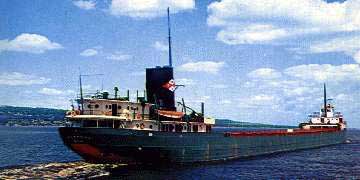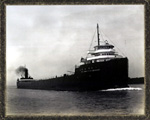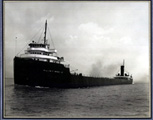The Shenango Furnace Company

SS ShenangoThe founder of the Shenango Furnace Company, William Penn Snyder, was born in Hollidaysburg, Pennsylvania in 1860.
William Penn Snyder was destined to become a visionary in the United States's steel industry. The son of a Methodist-Episcopal minister, Edmund Bowman Snyder and Mary McCoy Snyder, he began his business career as a sixteen year old office boy, with Pittsburgh iron merchant, Shoenberger and Company. With an intelligent mind young Mr. Snyder was a quick study and often promoted. In 1880, at age nineteen, he quit Shoenberger. He, and an older, age twenty, ex-Shoenberger co-worker named John G. A. Leishman formed a partnership. By the year 1885 the Pittsburgh iron brokerage firm of Leishman and Snyder was one of the most successful. In 1888 Leishman sold his partnership holdings to Snyder and took an offered interest in the Carnegie Steel Company. At the age of 27, as sole owner, Mr. Snyder changed the firm’s name to W. P. Snyder & Company. Mr. Leishman went on to become president of Carnegie Steel.
Henry W. Oliver, founder of the famous Oliver Iron Mining Company, took young Snyder under his wing. When Mr. Oliver took options on suspected iron ore bearing land in Minnesota's Cayuna and Mesabi ranges; he reserved portions for W. P. Snyder. William P. Snyder continued his wheeling and dealing, he bought or leveraged holdings to acquire interests in iron ore sites, blast furnaces, coke ovens and coal mines. In 1904 he became president of the Clairton Steel Company and built a large steel plant at Clairton, Pa; that he sold to United States Steel in 1906. Mr. Snyder then formed the Shenango Furnace Company and had all the holdings necessary to control the creation of steel from the raw ore to finished product. But he did not have control over the transportation of the ore. In 1906 he had Great Lakes Engineering Works in Ecorse Michigan construct his first Great Lakes ore carrier, naming it after himself, the SS William P. Snyder .
In 1909 Great Lakes Engineering works built the Shenango. In 1911 Mr. Snyder undertook a unique method to increase his fleet with little in the way of capital outlay. He approached Mr. Jones, of the Jones and Laughlin Steel Company in Pittsburgh. He arranged a deal with Mr. Jones to supply J & L iron ore in exchange for finished steel for the construction of a new ship. In addition ore for them to use as they saw fit, as profit. Now, you may ask yourself, why did he not just make the plates himself, in his own steel plants? Answer: In this era of rapid expansion in the steel making capacity of this country the products Mr. Snyder chose the Shenango Furnace Company to create were the crucibles and ingot molds used by steel plants. With this deal in hand he went to Great Lakes Engineering Works in Ecorse and got a price for the fabrication of his new ship. He then returned to Pittsburgh, and with his good name attached, floated a bond issue, that readily sold out, to pay for the new ship.
Click on the little images, below, to see larger versions. Taken in the forties these matted and framed pictures hang on the wall at my dad's house. For this project he took them down, removed the matted pictures from the frames and mailed them to me to be scanned. You sure can see they are sister ships.
 
At 617 feet length overall, 64 feet beam and a molded depth of 33 feet the SS Col. James M. Schoonmaker [left] was the largest great lake's ore carrier. It was then, and until 1937, the largest bulk freighter in the world. The next year Mr. Snyder swung the same deal for a sistership, the SS William P Snyder, Jr. [right] The profits from hauling ore with his fleet handily paid off the bond issues long before they matured. With his nowfive vessel fleet and other holdings Mr. Snyder's Shenango Furnace Company was one of the strongest of the independent companies of the steel industry.
Most Great Lakes vessels of the era were powered with two coal burning, hand fired, Scotch Marine Boilers and a Triple Expansion steam engine of about 2,000 horsepower. The triples had high, intermediate and low pressure cylinders. For his vessels Mr. Snyder chose three Scotch Boilers and 2, 500 horsepower, quadruple expansion engines with a high, two intermediates and low pressure cylinders. One of the highest accolades William Penn Snyder received was the offer, a few years later, to become the president of the United States Steel Corporation. Not many business men would make the decision he did - he refused the position, he preferred to continue to operate the businesses his efforts had built.
Mr. William Penn Snyder died in 1921 at age sixty-one. In 1926 The Shenango Furnace Company, now under the leadership of Mr. Snyder's son, William P. Snyder, Jr., sold the Wilpen and William P. Snyder. As of 1969 the Wilpen was owned and operated by the American Steamship Company and named the Joseph S. Young . Also, in 1969, the Snyder was owned and operated by Cement Transit Company under the name Medusa Challenger .
In 1952 The Shenango Furnace Company invested $4 million in its three vessel fleet. Oil fired D-Type Combustion Engineering Boilers and General Electric geared steam turbines were installed on the Shenango, 4,500 horsepower, and the Schoonmaker , 5,000 horsepower. The Snyder Jr got the CE boilers but they were moving grate stoker fired coal burning and she got a 4,500 horsepower, five cylinder, Skinner Marine Uniflow compound steam engine. The quarters and service areas on all three ships were modernized, the spar decks refurbished. Each ship was fitted with a new Lorain Radio Communications System and Sperry radar’s. In 1953 each ship carried “record” cargoes. The Snyder : 15,682 tons, Schoonmaker : 15, 868 tons and the Shenango : 13,172 tons.
1953 was also the year of the steel strike. Up to, and including that year, when there was a steel strike, most Great Lakes steamship lines kept their ships active and crews aboard hoping for a fast end to the strike. All three Shenango ships would have gotten a late season start anyway. The Shenango was first out and made several trips before the strike. She was anchored in the Duluth Harbor off Park Point, now named Minnesota Point, when the Snyder arrived, right out of the shipyard. My dad was Second Assistant on the Snyder and had not been home the previous winter. He was the owners representative for the Snyder's conversion. I remember well standing next to "our place" at the Duluth Entry when she came in. We usually "waved in" and "waved out" whichever ship my dad was on. In midsummer, when there may be crowds of tourists, we always stood in the same place so he could quickly pick us out. Is it still there? That huge hunk of copper ore? That's where we would stand. The Snyder went alongside the Shenango in the harbor and they rafted together. A few weeks later when the Schoonmaker made her maiden post conversion voyage, she joined the Duluth Harbor Shenango raft.
In 1958 the Shenango was sold to Wilson Marine Transit and her name was changed to the A.T. Lawson . In 1959 the Shenango Furnace Company brought out a new vessel, the 710 feet long Shenango II. In 1968 the William P. Snyder, Jr. and Shenango II were sold to the Pickands Mather and Company. The Shenango II was renamed Charles M. Beeghly. In March of 1969 the Col. James M. Schoonmaker, also, was sold to the Pickands Mather and Company. Thus ended the sixty three years of exemplary, trend setting leadership shown by the Shenango Furnace Company's distinctive green hull and orange boot topping fleet.
The foregoing brief history of the Shenango Furnace Company lakes fleet division would not have been possible without the following sources: This is Shenango, Copyright 1954 by The Shenango Furnace Company. The Lake Carriers Association Bulletin, Volume 58, No. 1, April-May 1969 pages 2, 3 & 4. Freighters of Fortune, The Story of the Great Lakes, by Norman Beasley, 1930. And, of course, the memory of my dad, Clem Hayden.
Click here for more triple expansion marine steam engine and scotch marine boiler information.
04-01-97 
Front Page |